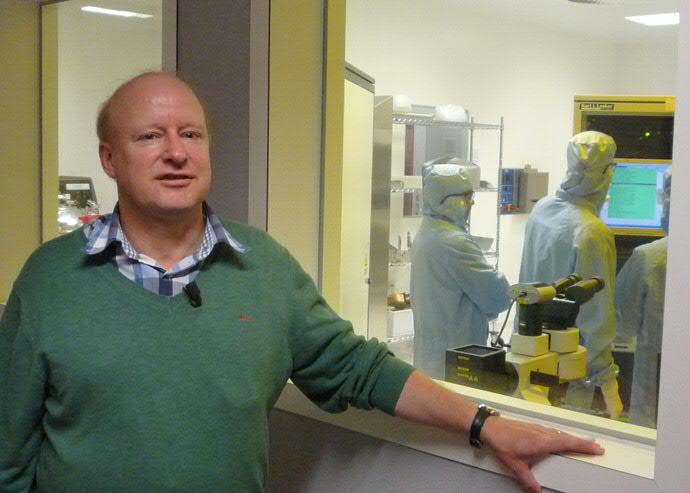‘Wave’ stuurt informatie door magneet

Natuurkundigen van de Rijksuniversiteit Groningen hebben, samen met collega’s uit Utrecht en Brest, een nieuw principe ontdekt waarmee informatie tussen elektronische circuits kan worden verstuurd. Maar het kan ook helpen om op efficiëntere manier stroom op te wekken uit warmteverschillen. De resultaten zijn op 14 september verschenen in het tijdschrift Nature Physics.
Het onderzoek stond onder leiding van Bart van Wees, hoogleraar technische natuurkunde aan de RUG en specialist in onder meer spintronica. Dit is een vorm van elektronica waarbij niet alleen de elektronen tellen, maar ook hun spin belangrijk is. Ieder elektron heeft een spin, een kwantummechanisch fenomeen, die twee waarden kan hebben: op of neer. Je kunt een elektron zo ‘coderen’ met informatie en die via ‘spinstromen’ transporteren.

Spinstromen
In het nieuwe onderzoek heeft Ludo Cornelissen, promovendus van Van Wees, laten zien dat spinstromen ook door isolatoren heen kunnen gaan. In het experiment werd een geleidend materiaal gecombineerd met een niet-geleidend magnetisch materiaal. Wanneer elektronen op het niet-geleidende materiaal botsen kunnen ze niet verder. Maar tijdens de botsing ontstaat een verandering in de magnetisatie waardoor de spin wordt overgedragen.
‘We maakten een opstelling waarin we een elektronenstroom omzetten in een spingolf, en die vervolgens even verderop weer terugvormden tot een elektronenstroom’, legt Van Wees uit. De spingolf in het niet-geleidende magnetische materiaal is een zogeheten magnon, een verstoring in de magnetisatie die zich verspreidt zoals een ‘wave’ door een vol stadion trekt: elektronen in het materiaal geven de spin aan hun buurman door en vallen daarna weer terug in de oorspronkelijke positie. Bij deze vorm van transport verplaatst alleen de spin zich, er reizen geen elektronen rond. Daarom ontstaat er geen warmte en kost het transport zeer weinig energie.
Nieuwe mogelijkheden
‘We hebben op deze manier als eersten het concept van spintransport verbonden aan magnetisatie-dynamica en laten zien dat spintransport ook in isolatoren mogelijk is’, vertelt Van Wees. Dat levert nieuwe mogelijkheden op. ‘Tijdens het transport door de isolator kun je de spingolf manipuleren, bijvoorbeeld via magneetvelden.’, legt Van Wees uit. Spingolven doven langzaam uit door wisselwerking met de atomen in het kristalrooster, maar Van Wees en zijn collega’s hebben laten zien dat de spingolf in ieder geval 10 micrometer in stand blijft. ‘En dat is lang zat. Maar hoe langer de golf is, hoe gevoeliger deze is voor veranderingen. Je zou er bijvoorbeeld sensoren mee kunnen maken die magnetisme detecteren.’
Het is ook mogelijk om magnetische bits te schakelen met een spingolf. ‘Met spingolven is een kleiner oppervlak te schakelen dan met elektromagnetische technieken, en het energieverbruik is ook hier gunstiger.’ Dit soort toepassingen hoeft niet heel ver weg te zijn. ‘Ik werk in principe het liefst met gewone materialen bij kamertemperatuur, zodat de stap naar toepassingen klein is.’
Een andere mogelijke toepassing ligt in thermo-elektriciteit, de omzetting van temperatuurverschillen in stroom. ‘Materialen die daarvoor geschikt zijn, zijn allemaal elektrische geleiders. Maar een elektrische geleider zal per definitie ook warmte geleiden. Daardoor lekt een deel van het warmteverschil weg.’ De paar bedrijven die thermo-elektriciteit op de markt willen brengen kampen dan ook met rendementen die ver beneden de theoretische mogelijkheden liggen. ‘Met ons materiaal kun je een spinstroom opwekken in een isolator, die dus ook geen warmte doorlaat. Dat biedt zicht op een hoger rendement.’
Meer informatie
Referentie: L.J. Cornelissen, J. Liu, R.A. Duine, J. Ben Youssef and B.J. van Wees, Long distance transport of magnon spin information in a magnetic insulator at room temperature.
Meer nieuws
-
17 december 2025
Ben Feringa wint Feynmanprijs
-
11 december 2025
Stormachtige planeten en een onverwachtse atmosfeer
